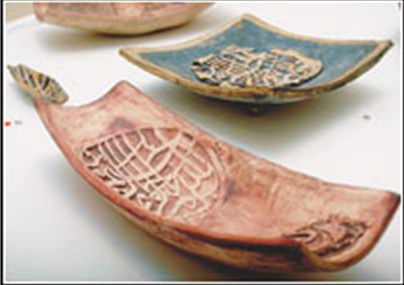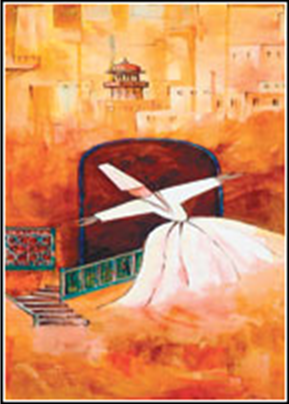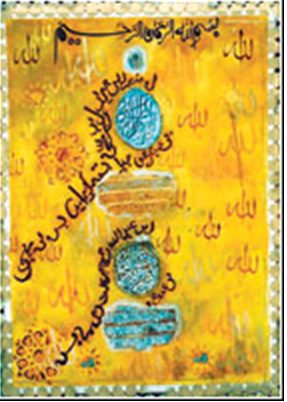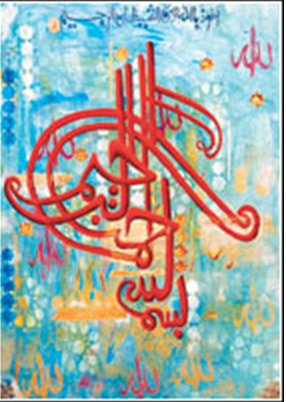Shahida Ahmed
This is a collection of articles archived for the excellence of their content. Readers will be able to edit existing articles and post new articles directly |
Shahida Ahmed
Spiritual And Artistic
By Shamim Akhter
In the East and in the West there seems to be parallel spiritual and artistic tendencies which inspire each other in a genuine and fruitful way.
Eastern calligraphy elicits a slightly different kind of response among eastern and western artists. For western painters, calligraphy, both Islamic and Far Eastern, is foreign and exotic. Owing to this, calligraphy probably has a stronger appeal for the western than it has for the eastern eye. And regardless of the fact that people in the West cannot read it, except in vary rare cases, it is endlessly appealing.
It is in this scenario that Shahida Ahmed, a UK born Muslim, selects calligraphy for her expressions; but more so because calligraphy is the most typical expression of the Islamic spirit and for her it is a quiet process of meditation. Living in the West, it becomes a question of her identity in the perspective of her culture. At the same time it is a spontaneous manifestation of her artistic ability. For her it is not an end in itself; it is correlated with other artistic intentions.
Exposed to the western art scene, Ahmed remains involved in the spiritual element of Arabic calligraphy and makes it a part of her identity, keeping herself in touch with her roots. The result is the emergence of her artistic realisations which are also in many ways, characteristic of the genius of the land she belongs to. Her social, historical and psychic link with her antecedents cannot be divorced from her creative activity. She seems to have conceived new vision either with a cerebral exercise or intuitive thinking. This is why her works stir our hearts.
On her canvas, she appears with full force decorating the centre with bold writing and then recedes, culturing her emotions and works in delicate writing using gold leaf, latex, enamel, acrylic and oil on canvas. Thus her calligraphy moves and lives on the flat surface. This is not merely the utterance of an ideogram for her. She understands the spiritual background of the writings. The flat surfaces seem to be the space of her mystical state of mind.
Her lines are the expression of an exalted state of the human existence and the point, where the inner and the outer reality meet. This way her art and meditation become one. Working with calligraphy, Ahmed resolves the issue of the strong western opposition of subject and object; of the artist and the work of art.
The decoration on her ceramics is a fusion of modern abstract Islamic text, geometric pattern and Islamic motif. She amalgamates her forms and decorations in a high order to represent Islamic art for its renowned qualities. In order to capture the lustre effect and colour quality, she fires her work using a Raku Kiln. This method renders her each piece an individual identity. Ahmed relates to the concept and techniques used by the Iranians for decoration. Raku firing help her achieve these results.
Ahmed works with clay for many reasons. It is a natural form and is able to capture the effect in her design. It has religious significance as well because man was created from clay.
Born and brought up in the UK, and with B. A. (Hons), degree in Visual Arts from the University of Leeds 1989-1991 and B. A. (Hons) in Art and Design from University of Bradford 1995-1996, Ahmed has accepted the forms of the other culture, but basically retains her own identity. She synthesised her home culture with learning from the world outside and creates strong new styles, especially in her calligraphy on canvas and ceramics.
On some of her canvases, she has used the line for geometrical shapes; the figures of dancing dervishes were introduced on four canvases when she was in Karachi working with a group of local artists. It was a breakthrough working in new environments.
Her huge body of work including 17 paintings and 28 ceramic works titled ‘Journey through Zikir’ was showcased at V. M. Art Gallery, Karachi, Pakistan. Her collective work reveals her sensibility to exploit the natural flow of Arabic script; its rhythmic and dynamic movement. She also reveals her sense of design on canvas and ability to maintain balance inherent in Islamic art.
Her lines are the expression of an exalted state of the human existence and the point where the inner and the outer reality meet



